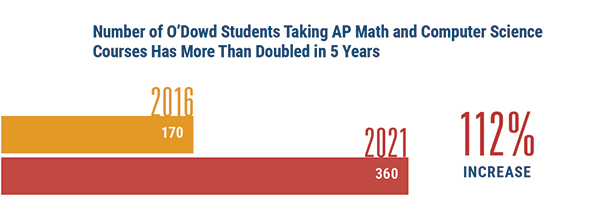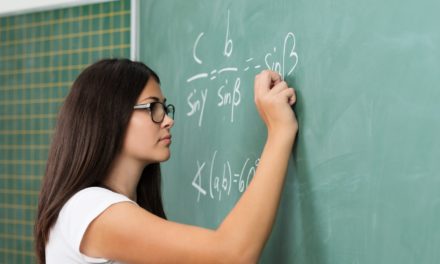Carlos Trujillo, Bishop O’Dowd High School Math Department Chair, teaching Advanced Placement Calculus.
Dynamic Futures in Math: Bishop O’Dowd High School Moves Students Ahead of the Curve
“There’s a problem with how we teach math in the United States,” explains Carlos Trujillo, Chair of Bishop O’Dowd High School’s Math Department. “The standard course sequence dates back to the Industrial Revolution. It’s not setting students up to master the skills they need to succeed in today’s world.”
In an effort to accelerate student access to upper level courses like Pre Calculus and Finite Math, the O’Dowd Math Department made a decision in 2018 to eliminate a more basic Algebra 2 course, instead offering an up-leveled Algebra 2 Trigonometry to all students. “By shifting every student into this more advanced class, we opened the gates for them to engage earlier in college prep courses that lean more towards their interests, whether that’s traditional STEM, business, or social entrepreneurship,” says Trujillo. Along those lines, the Department also added AP Computer Science Principles in 2016. “We’ve seen that course jump from 24 students in 2016, to 100 students this year,” Trujillo reports.

O’Dowd’s Math Department has also intentionally modernized its teaching methods, transitioning the classroom to a “flipped model” where students might watch a teaching video the night before class to preview concepts, and then come to class prepared to practice. “One of the most necessary skills in today’s world is collaboration,” Trujillo notes. “We’re supporting students to work in groups and attack a problem together. We want classes to be spaces of active learning, instead of passively taking lecture notes. And we’ve found that students master and own the material much more deeply through this model.”

AP Calculus students prepare for their end of semester finals.
Last year, in accordance with leading-edge research from the Stanford Graduate School of Education, The University of Chicago, and a growing cadre of mathematicians, data scientists, teachers, and education policy leaders, O’Dowd’s Math Department developed a new two-year geometry, algebra, and trigonometry sequence – an innovative course remodel designed to prepare students to be problem solvers in today’s tech and data economy.

As it stands now, most U.S. math students learn a sequence of Algebra 1 (one year), Geometry (one year), Algebra 2 (one year). “This math track is like learning to play piano one year, switching to cello for another year, then going back to piano as though you never stopped practicing,” Trujillo says. First, the sequence doesn’t support a true command of fundamental math concepts. “It’s how students get frustrated with math,” Trujillo notes. Second, this sequence usually doesn’t create enough time for students to take multiple upper division courses, like Data Science and Multivariable Calculus. “These are the courses that have a big payoff for students,” Trujillo explains. “They start solving real world problems, thinking creatively, and strengthening their college applications.”
O’Dowd’s two-year math sequence is focused on students mastering the concepts they need to be successful. “We don’t want students who just know how to do the mechanics.” Trujillo states. “We want them to gain the technical vocabulary, notational fluency, the analytical skills, and the conceptual thinking that matter for problem solving. It’s like an exponential function. Our student’s mastery will compound and accelerate over four years and put them at an advantage when it comes to pursuing STEM careers.”
The shift also opens the pathways for all students to take AP Calculus by their junior or senior year – something less than 10 percent of students were previously able to achieve.
“By creating this intentional two-year sequence, we’re giving students a rock solid foundation to excel in Pre Calculus, Finite Math, Data Science or even AP Calculus as juniors,” Trujillo emphasizes. From there, there are a range of AP courses they can take, even Multivariable Calculus. “We are one of only a few high schools in the nation that teaches this,” Trujillo says. Multivariable Calculus lays the mathematical foundation for machine learning and theoretical computer science. “We need to be preparing students to be drivers and innovators of the kinds of systems that Google Maps and Spotify are built on,” Trujillo insists. “They’re going to keep changing the world.”
“I took AP Calculus and AP Computer Science Principles in 11th grade. O’Dowd’s math teachers don’t just explain concepts like the quotient derivative rule, they support us to develop a growth mindset. Through math, I’ve learned that brains and talent are a good starting point, but it takes hard work and dedication to succeed. Teachers like Mr. Trujillo have given me confidence to meet any challenge – in an equation or in life.”
Diego, 12th Grade

Honors Pre-Calculus students work on graphing equations.
O’Dowd’s move to modernize the Math Department is already ahead of the curve. Last year, the University of California and the California State Universities made changes to accept courses in data science as equivalent to Algebra II, pointing towards the relevance of data science to analyze and tackle social problems, from climate change to crime. Other elite colleges may follow soon.
“Our Math Department is reading the economic landscape and leading innovation,” declares O’Dowd Board Member and alumna Melinda Eisenhut-Dunn ’74. As the former CFO of Sequoia Capital, a $20B global investment firm, Melinda knows how important it is for education to expose young people to disciplines that connect to our emerging marketplace. “O’Dowd is looking ahead,” she says. “We’re equipping our graduates to become leaders in the next generation of our society.”
Bishop O’Dowd High School is a Catholic college preparatory community that engages students in learning experiences that encompass mind, body and spirit, and emboldens graduates to build a more just, joyful and sustainable world.
To learn more about O’Dowd’s award-winning programs, visit bishopodowd.org/admissions
Click here to view Bishop O’Dowd High School’s school profile
Sponsored content provided by Bishop O’Dowd High School.



















